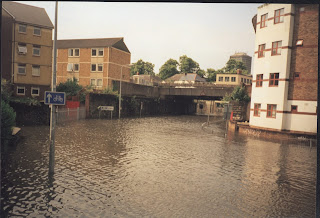The worst thing about being human is also the best thing! We don’t react/act proactively until the proverbial shit hits the fan! Yes when it comes to fires, over the years we’ve built our communities to have sprinkler systems, quicker access via route planning for Fire Engines, materials that are more resilient to fires/heat damage etc. Yet all too often we should try and make efforts to deal with problems before they start.
 At present UK is having a dry
spell with a lot of bright hot weather of direct sunlight bathing the
countryside and urban areas of Britain. Within a fortnight our agricultural
systems, small holdings, community gardens, back gardens etc. see the early
signs of strain as water disappears quickly and we don’t have sufficient back
up resources.
At present UK is having a dry
spell with a lot of bright hot weather of direct sunlight bathing the
countryside and urban areas of Britain. Within a fortnight our agricultural
systems, small holdings, community gardens, back gardens etc. see the early
signs of strain as water disappears quickly and we don’t have sufficient back
up resources.
Water saving measures is
something we often forget. Caught up in standard 70-80 hour weeks that many
citizens face up to on a regular basis means our minds are stretched thin
juggling multiple tasks, coupled in recent years in explosion in social media
that stretches us that little bit more. We forget things, priorities jump
queues and non-immediate threats slide down the triage …..
With hot perfect ideal spring
& summers becoming potential droughts – it’s time we put some checks &
balances into play. If it was mandatory in every city/major town that each
household must have a water collection measures – be it;
·
Nature: Water Butts – for gardening, community
gardens and expanded managed green spaces
·
Domestic/office: Rainwater collection for toilet
flushing, showers etc.
·
Industry: mass retention points for cooling etc.
The opportunities are
significant. During drought periods to have a few million litres in water butts
ready to bail us out. It’s not really that hard considering that 1 million
litres = assuming 150 litre water butt capacity = just over 6,600 water butts;
just a few dozen extra Water Butts in every town & city will make a
significant difference. What is London has to add in 10,000 new water butts –
major fresh rain water resource to help us in the hot/dry season!!
Yet what about the opposite and
it floods? Would all these empty water butts help absorb some of the heavy downpours
which does hit UK at times. Yet if the 1 million Water Butts are half full at
the time have they prematurely outlasted their usefulness? Where else can we
put rainwater storage? On every level of high rises? Can City Farms LINK
be centres of clean natural rainwater (harvested) resource? If a transport
accident resulted in contamination hitting the river eco-system; would
1,000,000 Water Butts who are directed to flush into the river system help
dilute the contaminated river? This blog is not presenting solutions – rather
inviting you to think about the logistics of rainwater harvesting, when to
store, when to use, when to utilise in emergency etc.
COSTS: always the thing we don’t
want to hear! Yet how can you on a basic and very localised start get your
rainwater collection initiative started? Recovery of used/discarded Water Butts
may be one format forward – be it looking at business junkyards or council
skips/recycling centres, using Freecycle LINK, asking amongst your own
community if they are imminently about to thrown any water butts out if you can
freely recover them?
It all starts with small steps.
You may be surprised in your own locale at how many people would wish to get
involved in such a project. Its up to you to reach out and find everyone.
Is
smart-micro-water-grid and analogy or reflective of an
electricity-micro/smart-grid? Can the two work in tandem together – or as a
three with heat-smart-grid, or local-food-smart-grid? Is this all the cusp of
something bigger to come which we all need to initiate in our own areas ……?
What can you do?

No comments:
Post a Comment